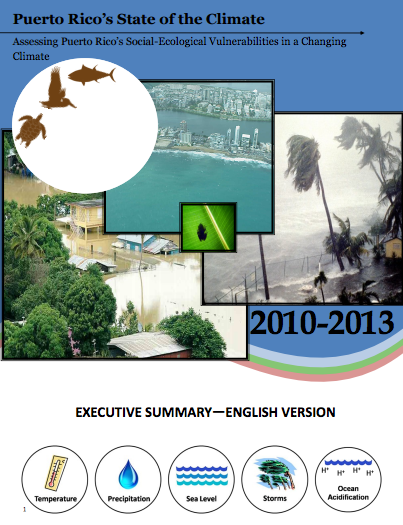Puerto Rico’s State of the Climate 2014-2021: Assessing Puerto Rico’s Social-Ecological Vulnerabilities in a Changing Climate

Posted by
CAKE TeamPublished
Abstract
The climate of Puerto Rico is influenced by the changing global climate. The following chapters present the current knowledge of the geophysical and chemical drivers and signals of global climate change as they affect the climate of Puerto Rico and influence the climate-dependent services, risks, and vulnerabilities that govern human well-being. These include sustainable economic development, delivery of ecosystem services, the conservation of natural and cultural resources, resiliency in built and natural systems, and food security.
The chapters draw on global expertise of land, atmosphere, and ocean geophysical interactions associated with increasing greenhouse gases (GHG) that drive global warming and on local scientific expertise, data, observations, and modeled projections. They present the global warming scenario (section 1), the contribution of Puerto Rico to global climate change as GHG emissions and aerosols (section 2), the context of natural climate variability (section 3), observed and projected trends in temperature (section 4), rainfall (section 5), sea level rise (section 6), ocean acidification and sea surface warming (section 7), and the expected implications of warming climate on tropical cyclones affecting Puerto Rico (section 8).
El clima de Puerto Rico está influenciado por el cambio climático global. Los siguientes capítulos presentan el conocimiento actual de los impulsores geofísicos y químicos y las señales del cambio climático global que afectan el clima de Puerto Rico e influyen los servicios, riesgos y vulnerabilidades dependientes del clima que gobiernan el bienestar humano. Estos incluyen el desarrollo económico sostenible, la prestación de servicios ecosistémicos, la conservación de los recursos naturales y culturales, la resiliencia en los sistemas naturales y artificiales y la seguridad alimentaria.
Los capítulos se basan en la experiencia global de las interacciones terrestres, atmosféricas y geofísicas oceánicas asociadas con el aumento de los gases de efecto invernadero (GEI) que impulsan el calentamiento global y en la experiencia científica local, los datos, las observaciones y las proyecciones modeladas. Se presenta el escenario de calentamiento global (sección 1), la contribución de Puerto Rico al cambio climático global como emisiones de GEI y aerosoles (sección 2), el contexto de la variabilidad climática natural (sección 3), las tendencias observadas y proyectadas en la temperatura (sección 4), precipitación (sección 5), aumento del nivel del mar (sección 6), acidificación de los océanos y calentamiento de la superficie del mar (sección 7) y las implicaciones esperadas del calentamiento del clima en los ciclones tropicales que afectan a Puerto Rico (sección 8).
Citation
Puerto Rico Climate Change Council (PRCCC) (2022). Puerto Rico’s State of the Climate 2014-2021: Assessing Puerto Rico’s Social-Ecological Vulnerabilities in a Changing Climate. Puerto Rico Coastal Zone Management Program, Department of Natural and Environmental Resources, NOAA Office of Ocean and Coastal Resource Management. San Juan, PR.





